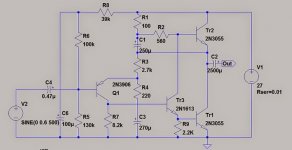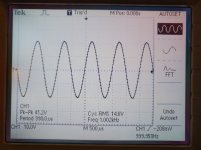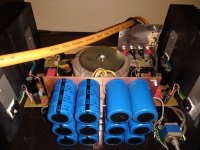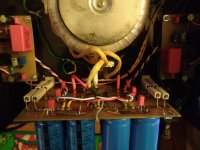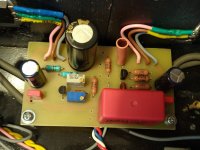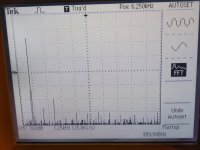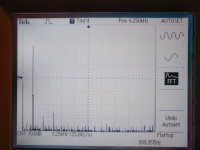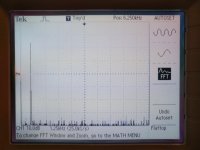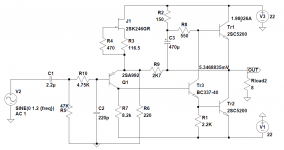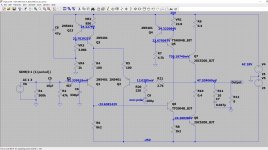Me too. The high current seems to offer statistically lower distortion ( very slightly ). The JLH recomended current seems very like Jean Hiraga suggested as ideal in the 1980's. I could imagine the high current to sound more old fashioned or slightly dead. If true is saves money not to want the higher current.
I know Jean lives in Lille France. I sometimes travel to Tournai in Belgium it's near neighbour. One day I might find the courage to visit should he say yes. Jean more than anyone asked why we like things. He knows enough about circuit design to ask the right questions. I remember his review of the Coral 777EX MC pick up circa 1982. It was low cost and well liked in a group test. He observed the distortion spectrum fell on a straight line or more likely an exponetial. In that or other text he gave me to understand that if distortion is below 1% and not caused by crossover glitches an exponential decay of distortion will be heard as zero distortion. The reason being is the relative distortion is zero if the proportions are as in the original signal. I liken this to saturating colour on a TV at worse. With TV it is more difficult to be objective as we only have our own imagination to do the adjustment. Subtly if 0.1% of the same type it is better. Whereas a 1970's high feedback amplifier design might have 0.005% distortion yet sound wrong. This will be that the residual 5th and 7th harmonics remain uncorected. If the feedback loop is relaxed the 5th and 7th will remain and might even grow a little. The 2nd and 3rd will rise up to swamp them. The sound will be much more neutral.
People say this is subjective over objective. Not really true. The ear works by processing sound in a device with an exponential shape. It can process sound that resembles it's own distortion and infer the correct sound. Work I helped with using real ears suggests the distortion is 30% before the brain processes it. The Hamster resembles a human better than a mouse as mice do not hear the low frequencies we can. The Hamster is useless as far as time delay is concerned. Time delay and stereo are related. The human brain has the 30% analogue distortion part, a digital style transducer ( hairs ) and a very fast return signal from the brain who's function is not known. It could be a servo loop. It's responce time is <1uS and might say why we like fast devices which in theory we can not hear. The dullness John Ellis notes is likely this. A speaker that rolls at 10 kHz sounds dull to me on 78's which should not matter , even 1920's ones . It matters more than CD!
JEAN HIRAGA - Le Monstre Amplifier PCB
https://pdfs.semanticscholar.org/176c/7830d48ca5bbc0230adde647cd59f8852eda.pdf
I know Jean lives in Lille France. I sometimes travel to Tournai in Belgium it's near neighbour. One day I might find the courage to visit should he say yes. Jean more than anyone asked why we like things. He knows enough about circuit design to ask the right questions. I remember his review of the Coral 777EX MC pick up circa 1982. It was low cost and well liked in a group test. He observed the distortion spectrum fell on a straight line or more likely an exponetial. In that or other text he gave me to understand that if distortion is below 1% and not caused by crossover glitches an exponential decay of distortion will be heard as zero distortion. The reason being is the relative distortion is zero if the proportions are as in the original signal. I liken this to saturating colour on a TV at worse. With TV it is more difficult to be objective as we only have our own imagination to do the adjustment. Subtly if 0.1% of the same type it is better. Whereas a 1970's high feedback amplifier design might have 0.005% distortion yet sound wrong. This will be that the residual 5th and 7th harmonics remain uncorected. If the feedback loop is relaxed the 5th and 7th will remain and might even grow a little. The 2nd and 3rd will rise up to swamp them. The sound will be much more neutral.
People say this is subjective over objective. Not really true. The ear works by processing sound in a device with an exponential shape. It can process sound that resembles it's own distortion and infer the correct sound. Work I helped with using real ears suggests the distortion is 30% before the brain processes it. The Hamster resembles a human better than a mouse as mice do not hear the low frequencies we can. The Hamster is useless as far as time delay is concerned. Time delay and stereo are related. The human brain has the 30% analogue distortion part, a digital style transducer ( hairs ) and a very fast return signal from the brain who's function is not known. It could be a servo loop. It's responce time is <1uS and might say why we like fast devices which in theory we can not hear. The dullness John Ellis notes is likely this. A speaker that rolls at 10 kHz sounds dull to me on 78's which should not matter , even 1920's ones . It matters more than CD!
JEAN HIRAGA - Le Monstre Amplifier PCB
https://pdfs.semanticscholar.org/176c/7830d48ca5bbc0230adde647cd59f8852eda.pdf
Last edited:
Imo the "baddest" harmonics from a hi-nfb amp are if you play "heard" bass frequencies like 80-120Hz then the "bad" harmonics fall into the "nasal" range; and if you play the "nasal" tones - then the "bad" harmonics fall into the "sensitive" range 3-4k. If you play the "vocal" range then the "bad" harmonics fall into the "fizz" frequencies which often get masked with other hi-freq stuff in the recording.
That's why active crossovers and multiple amps are an improvement, assuming done right.
Less power sucking passive crossovers in signal is another benefit, not to mention easy level adjustment for various speaker efficiencies.
That's why we keep building more and more amps.
Less power sucking passive crossovers in signal is another benefit, not to mention easy level adjustment for various speaker efficiencies.
That's why we keep building more and more amps.
I had a very odd experiance with active crossovers recently. A friend bought a semi-professional unit to replace a broken one. A Fostex mid high and Leak 12 inch bass. Using 4 th order filters via NE5532 is for the first time ever it sounded correct! Usually we take 4 th order to be for power handling. I was impressed. An open mind in all things is important. His top amp is a SE KT88 driven by 12BH7A and ECC83 with class D bass amp.
2017 Nouveau Nobsound Linkwitz Riley Crossover Electronique 2 Way Diviseur de Frequence 2 Band Poignee Preampli dans Amplificateur de Electronique sur AliExpress.com | Alibaba Group
Fostex FE168E© 6.5 inch Full Range Speaker | Loudspeaker freaks
YouTube
2017 Nouveau Nobsound Linkwitz Riley Crossover Electronique 2 Way Diviseur de Frequence 2 Band Poignee Preampli dans Amplificateur de Electronique sur AliExpress.com | Alibaba Group
Fostex FE168E© 6.5 inch Full Range Speaker | Loudspeaker freaks
YouTube
Hmm... three vintage old dog opamps usually have the effect of making circuits "sound right" (if the design allows it): NE5532, LM833 and OPA2134 (*). The latter usually works when circuit was designed for bifet opamps and 5532 and 833 don't quite fit there. With "sounding right" I don't really mean "an improvement", just plain vanilla "right". Which isn't bad after all.
The 5532 and old design 833 both have a totempole output.
* (Maybe also a RC4559.)
The 5532 and old design 833 both have a totempole output.
* (Maybe also a RC4559.)
The good news is the company has fitted DIL sockets so anything can be fitted. MC33078 is a nicer NE5532 type as was the old OPA2604. The MC33078 is simpler so sounds less processed. The OPA had the drive of the NE5532.
If you get interested in the full range drivers by sure to think of a super tweeter. I cross mine at 6 kHz first order. Even on 78's I hear a more open sound. Even ones that have been digitally processed. My tweeter isn't really a super tweeter. It's just very happy working less hard with a higher crossover point. I selected mine to be of similar sensetivity to the full range unit. The dramatic improvement is a much better sound stage. A happy accident of compatible phase shifts I feel.
If you get interested in the full range drivers by sure to think of a super tweeter. I cross mine at 6 kHz first order. Even on 78's I hear a more open sound. Even ones that have been digitally processed. My tweeter isn't really a super tweeter. It's just very happy working less hard with a higher crossover point. I selected mine to be of similar sensetivity to the full range unit. The dramatic improvement is a much better sound stage. A happy accident of compatible phase shifts I feel.
Member
Joined 2009
Paid Member
interesting observation Nigel - do you think it would still be necessary to add a high-tweeter if you were to boost the high treble at line level with the full-range only or is there just too much fall off from the full range - or your ears ?
I have done that and the tweeter works best. I think it's the brick wall filter that the full range unit gives.
The big bonus I got was it seems there was a happy marriage that opened the sound stage. Pure luck I think. Crossing at 8 kHz wasn't as good. The Spendor BC1 is at 10 kHz. I question if that's best. However the BC1 tweeter will do 15 kHz. The STC ITT 4001G was added for TV work. TV had 25 x 625 or 30 x 525 ( circa 16 kHz ) and FM 19 kHz that the BC1 had to show. Without super-tweeter it was like BBC LS5/8 ( ? ). There is a suck out at 10 kHz with the BC1. This suggests phase inversion. My speakers are in phase for the super- tweeter.
The big bonus I got was it seems there was a happy marriage that opened the sound stage. Pure luck I think. Crossing at 8 kHz wasn't as good. The Spendor BC1 is at 10 kHz. I question if that's best. However the BC1 tweeter will do 15 kHz. The STC ITT 4001G was added for TV work. TV had 25 x 625 or 30 x 525 ( circa 16 kHz ) and FM 19 kHz that the BC1 had to show. Without super-tweeter it was like BBC LS5/8 ( ? ). There is a suck out at 10 kHz with the BC1. This suggests phase inversion. My speakers are in phase for the super- tweeter.
hello all 🙂
I have been reading about the JLH1969 here and there...i would like to build a smal amp around 10watts or more per channel thats great for listening to jazz. what verison of JLH and what schematic should i build.?? please do point me to the right schamatic and parts list and any tips on troubleshooting or mods recommended for great sound.
Thanks in Advance!!
Warm Regards
Amit
I have been reading about the JLH1969 here and there...i would like to build a smal amp around 10watts or more per channel thats great for listening to jazz. what verison of JLH and what schematic should i build.?? please do point me to the right schamatic and parts list and any tips on troubleshooting or mods recommended for great sound.
Thanks in Advance!!
Warm Regards
Amit
there is a version with modern transistors 2N3906, BD139, MJL21194. sch made and tested by theslowdiyer and PCB by me😉.
JLH 10 Watt class A amplifier
regards
Prasi
JLH 10 Watt class A amplifier
regards
Prasi
Hi,
Thanks for the information. How does your amp sound?? 🙂 . Would it possible to get some pcb's for this from you?? do let me know via direct message.
Thanks!
BR
Amit
Thanks for the information. How does your amp sound?? 🙂 . Would it possible to get some pcb's for this from you?? do let me know via direct message.
Thanks!
BR
Amit
I am not selling any pcbs for this, nor have i tested it, circuit tested by the theslowdiyer.... gerbers are posted, you can order it on your own..
if you need any help, let me know
if you need any help, let me know
ok. thanks. what kind of power supply is needed to be built. can i use a 12 volt 4 amp dc smps supply??
regards
Amit
regards
Amit
have a read here, it will answer all your questions
The Class-A Amplifier Site
and also the theslowdiyer site
JLH 1969 revisited… | theslowdiyer
The Class-A Amplifier Site
and also the theslowdiyer site
JLH 1969 revisited… | theslowdiyer
I tried BC337-40 for Tr3 and I can say that the amplifier with it sounds great. At BC337 I put a small copper cooler pipe. I also made some measurements at +/- 22V, bias 2A, load 8ohm, 14V RMS.Hfe for BC337 is about 400, 2SD468 300 and 2SC2383 180.
Attachments
Last edited:
nook. thanks. what kind of power supply is needed to be built. can i use a 12 volt 4 amp dc smps supply??
regards
Amit
Hi All, attached is a dual rail supply, CCS variant with differential input. Quick question, what is the recommended current for the differential input Q1 and Q2? Is the CCS Q3/Q13 adequate for this purpose?
To make the dc offset to zero, the differential input ccs is running as low as 0.79mA. Not sure if it is a good idea or not.
Please feel free to download and play with the circuit, any recommendation or modification are more than welcome!
To make the dc offset to zero, the differential input ccs is running as low as 0.79mA. Not sure if it is a good idea or not.
Please feel free to download and play with the circuit, any recommendation or modification are more than welcome!
Attachments
Last edited:
You may have missed the earlier posts ...
a differential input stage gives worse distortion than single ended input in this design because second harmonic distortion in the VAS stage is not countered by the diff input, which by itself is of course more linear than the singleton.
a differential input stage gives worse distortion than single ended input in this design because second harmonic distortion in the VAS stage is not countered by the diff input, which by itself is of course more linear than the singleton.
I tried BC337-40 for Tr3 and I can say that the amplifier with it sounds great. At BC337 I put a small copper cooler pipe. I also made some measurements at +/- 22V, bias 2A, load 8ohm, 14V RMS.Hfe for BC337 is about 400, 2SD468 300 and 2SC2383 180.
That's as far as I would dare go at +/-22V. 14 V rms is excellent. Did you get any small oscillation at 500kHz or above?
- Home
- Amplifiers
- Solid State
- JLH 10 Watt class A amplifier
